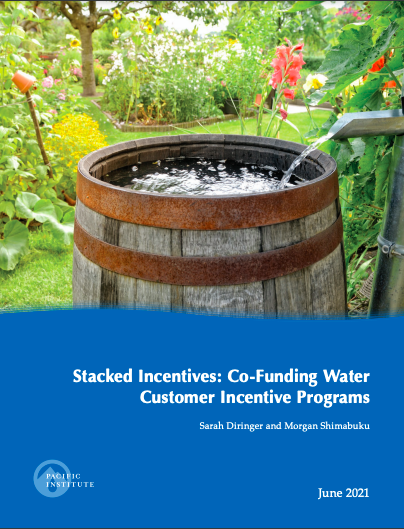Stacked Incentives: Co-Funding Water Customer Incentive Programs

Stacked Incentives: Co-Funding Water Customer Incentive Programs
Overview
Water utilities throughout the United States offer customer incentives to motivate action and foster engagement with their customers. These incentive programs can take many forms, from rebates for high-efficiency fixtures and appliances to technical assistance for installing cisterns and rain gardens. In addition to providing water-related benefits, many of these programs generate additional co-benefits, including reductions in energy use for heating or treating water and wastewater, increased carbon sequestration in landscapes, enhancements to local biodiversity, and more. These co-benefits present water utilities with an opportunity to build collaborative partnerships and co-funding for customer incentive programs through “stacked incentives.”
Stacked incentives are customer incentive programs that are co-funded by two or more separate entities to motivate voluntary action on public or private property. This approach provides water utilities with an opportunity to increase funding for customer incentive programs through collaborative partnerships, improve marketing and engagement with customers, increase access to incentives for low-income households, and more.
This report defines stacked incentives, highlights successful examples throughout the United States, and identifies best practices for water utilities and other organizations to collaborate on these programs.
Key Findings
Key findings from the report include:
Water managers are collaborating to develop and co-fund “stacked incentives” for water customers throughout the country, and there are opportunities for more. Stacked incentives are co-funded rebate, technical assistance, and education programs that help scale multi-benefit incentive programs. These programs include, for example, collaborations among water conservation and stormwater departments to offer rebates for removing turf and replacing it with a rain garden. There are opportunities to advance these multi-benefit incentive programs throughout the country.
Stacked incentives help increase investments in water strategies that achieve multiple benefits. Coordination and collaboration may not be easy, but the benefits of combining efforts, funding, and other resources can outweigh the costs for both the collaborating entities and the customers.
Third party coordinators help support successful program development, coordination, and outreach. During interviews, water managers throughout the country noted that third party coordinators were nearly essential for successful stacked incentive programs. By engaging a third-party coordinator, many entities were better able to simplify engagement with customers and increase overall uptake of the program.
When implemented well, stacked incentive programs may deliver more equitable incentive programs. Stacked incentive programs can help improve low-income assistance programs by increasing the total value provided by the incentive, reducing the number of applications necessary to apply for incentive programs, and engaging local community groups to help administer the programs.
Stacked incentives provide opportunities to build local water and climate resilience. Building programs that improve climate resilience will require many of the same processes as developing stacked water incentives: examining program alternatives; determining benefits; connecting benefits with beneficiaries; and building partnerships to implement programs. As these avenues mature, it is essential that stacked customer incentive programs and other collaborative funding models are included.

